Thousands of Koli fishermen living in the Golden Belt of the Arabian Sea stare at a loss of livelihood as Maharashtra’s most famous fish is succumbing to unrestrained fishing, rampant infra development and rapidly warming ocean. And look where it’s headed!
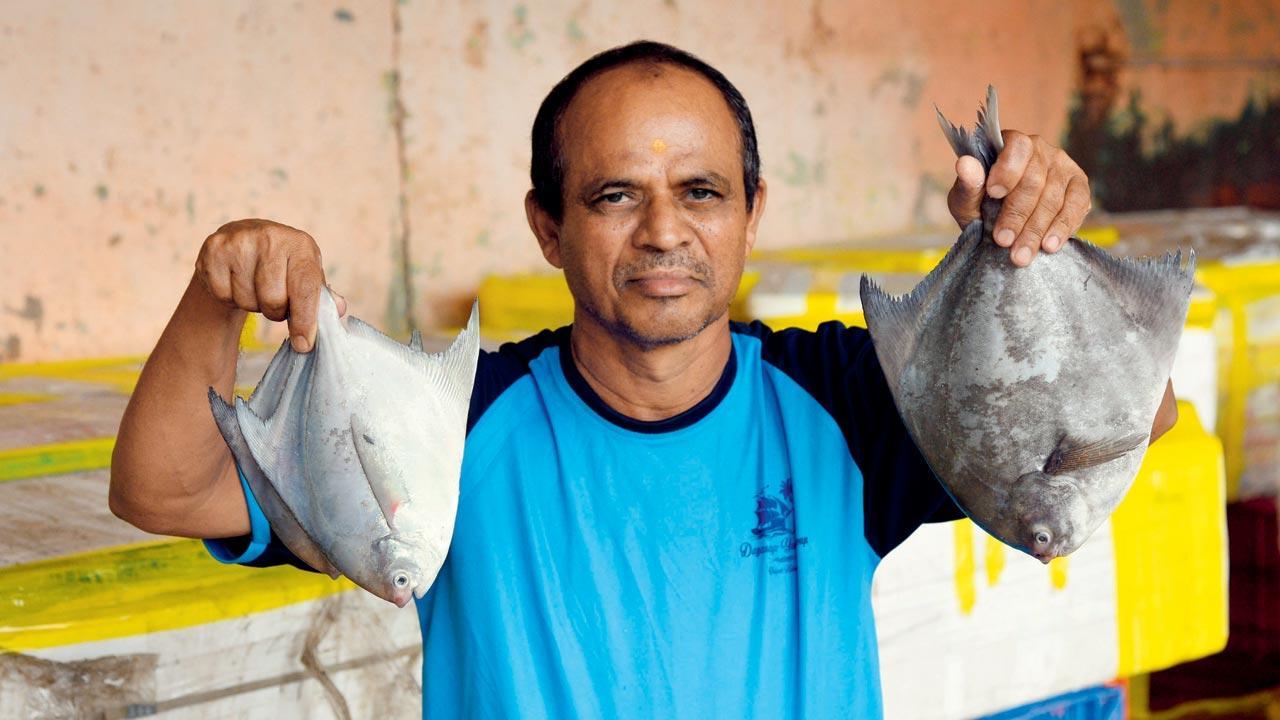
Prahlad Patil, a Koli resident of Satpati, Palghar, who works at the Satpati Fishermen Sarvoday Sahakari Society Ltd, shows a one-kilo weighing super pomfret and its grade 1 version, which are exported to China, the UK, and the Gulf and European countries, via Gujarat. Fishermen say that the larger-sized pomfrets have been depleting in number over the last 30 years. Pic/Satej Shinde
In Satpati, a coastal village 103 km from Mumbai, where the smell of fish and the taste of salt hugging the gentle breeze are gifts of its abundant sea, the sluggish weeks have come to an end. When we arrive late on a Wednesday morning, after travelling for three hours, the village appears abandoned except for a bunch of teenagers, inspired by their hometown hero Shardul Thakur, playing cricket on a grassy patch. “Everyone is out at sea,” Chandrakant Tare, a fisherman turned banker, and the chairman of Satpati Fishermen Sarvoday Sahakari Society Ltd, tells us at his office.
ADVERTISEMENT
The ban on fishing, enforced by the Maharashtra Marine Fishing Regulation Act, 1981 during the monsoon season to allow breeding and replenishment of stocks, was lifted on August 1. The fishermen have been away since. They will only return 10 days from now. Perhaps even later if the Arabian Sea is generous. It’s not for nothing that this Palghar coastline is called the Golden Belt. The waters hold precious wealth—from the rare and prized ghol fish, to surmai, shark, prawn, Bombay Duck, and silver pomfret/paplet or saranga as locals call it—which have sustained livelihoods for generations.
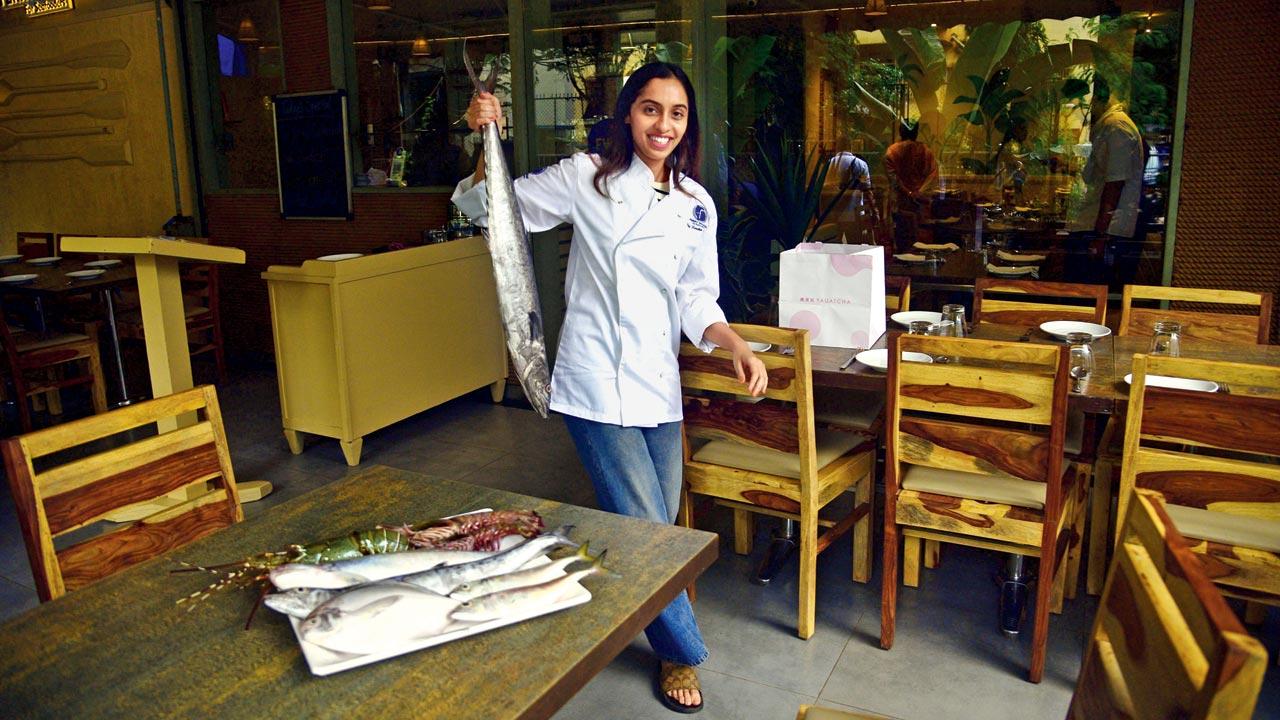 At Ferry Wharf Restaurant in Bandra, Chef Sanika Shetty says the wait staff present diners with a platter of the day’s catch, which would include everything from lobster, surmai, mackerel to tiger prawns. This helps them make a better choice than the popular paplet. Pics/Pradeep Dhivar
At Ferry Wharf Restaurant in Bandra, Chef Sanika Shetty says the wait staff present diners with a platter of the day’s catch, which would include everything from lobster, surmai, mackerel to tiger prawns. This helps them make a better choice than the popular paplet. Pics/Pradeep Dhivar
“But in the last two decades, pomfret has depleted, both in size and number,” Chandrakant informs. Earlier in the month, the fishermen’s society (established in 1947) requested Fisheries Minister Sudhir Mungantiwar and Union Fisheries Minister Parshottam Rupala to set measures for the preservation of the species by declaring saranga the state fish of Maharashtra. “It would aid in maintaining a balanced and protected marine environment while conserving the economically significant seafood,” their communication said, and “foster collaboration between fishermen, coastal communities, and government agencies”.
Chandrakant, whose office is located right above the cold storage where stocks for local markets and export are stored, is joined by members of the society, all fishermen, who have sent their boats out with their relatives. They take us through a stack of annual reports printed by the 76-year-old society that currently boasts of 3,000+ members and 136 boat-owners.
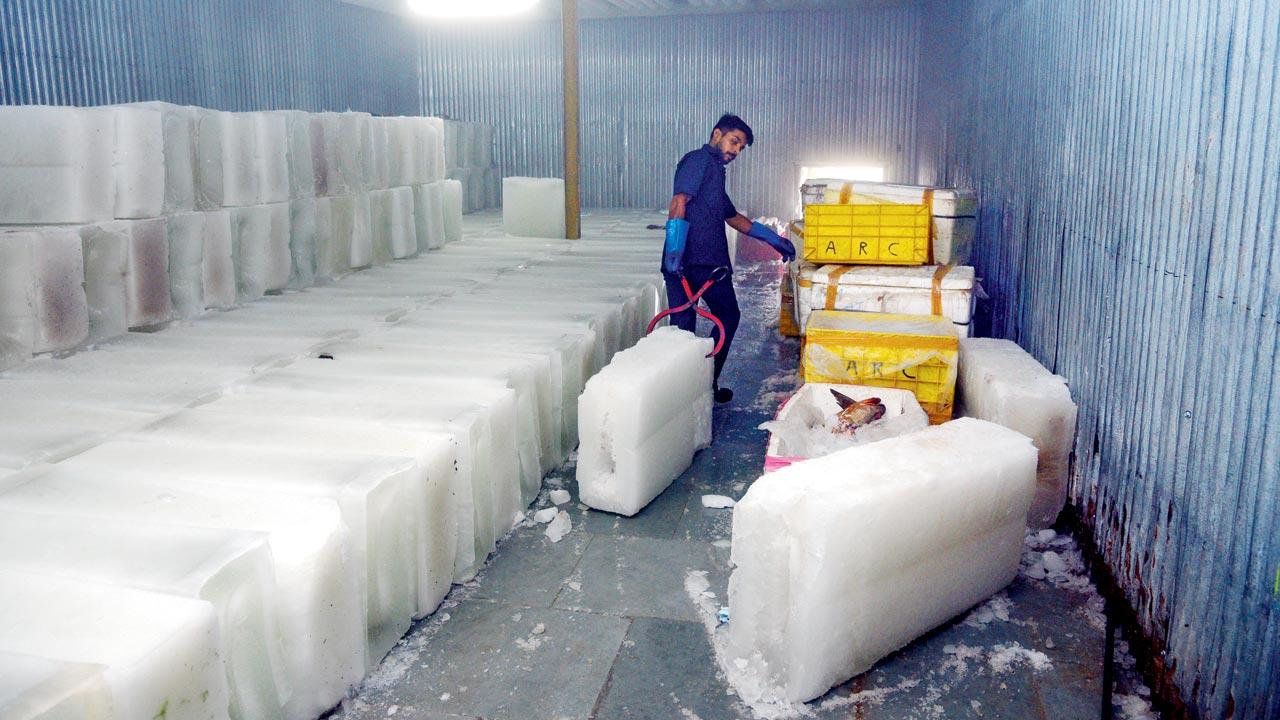 The Satpati fishermen’s society works as a liaison for the local fishermen, handling packaging and export of their haul, while also providing nets, diesel and cold storage. Pics/Satej Shinde
The Satpati fishermen’s society works as a liaison for the local fishermen, handling packaging and export of their haul, while also providing nets, diesel and cold storage. Pics/Satej Shinde
Recording and tabulating data on all fish, including pomfret, is key. Sanjay Tare, ex-chairman and member of the board of directors, shows us a table on the grades of pomfret pulled out annually. The grading system was introduced in 1975 after the fish began to be exported. A publication from 25 years ago shows three grades—super saranga (500 gm and above), followed by saranga no. 1 and saranga no. 2, which weigh 400 gm and 300 gm respectively. These fetch price as per their weight, with a kilo going at R1,500. “These were the only three grades of pomfret available in Satpati till the late 1990s,” he says. In 1990-91, Satpati’s 119 boat-owners netted 1,46,797 kg of super saranga alone. By the end of the decade, while the number of boats increased to 162, the super saranga catch dropped staggeringly to 33,184 kg. The quantity of saranga no. 2 rose from 74,499 kg to 1,84,447 kg. The downward trend continued into the new millennium.
“After 2000, our fishermen only started getting smaller-sized pomfret in larger quantities,” says Sanjay. That’s when grades like saranga no. 3 and no. 5, weighing between 150 and 250 gm, were introduced. Local fish markets today are inundated with chhota paplet. As of 2022-23, the super saranga haul stood at 4,508 kg, while the numbers of saranga no. 2 (24,871 kg), saranga no. 3 (30,150 kg) and saranga no. 5 (33,030 kg) rose. In fact, Sanjay says juvenile pomfret that weighs 150 gm and less is also being caught and sold. “This is hurting the livelihood of fishermen.”

Palghar’s Golden Belt is the nerve centre for silver pomfret trade in the state. The fish is not just sold in local markets, including Mumbai and Pune, but also sent to Gujarat from where it is exported to the Gulf, China, the UK, and various European countries.
A combination of factors are responsible for the decline in Palghar’s pomfret catch, says Chandrakant.
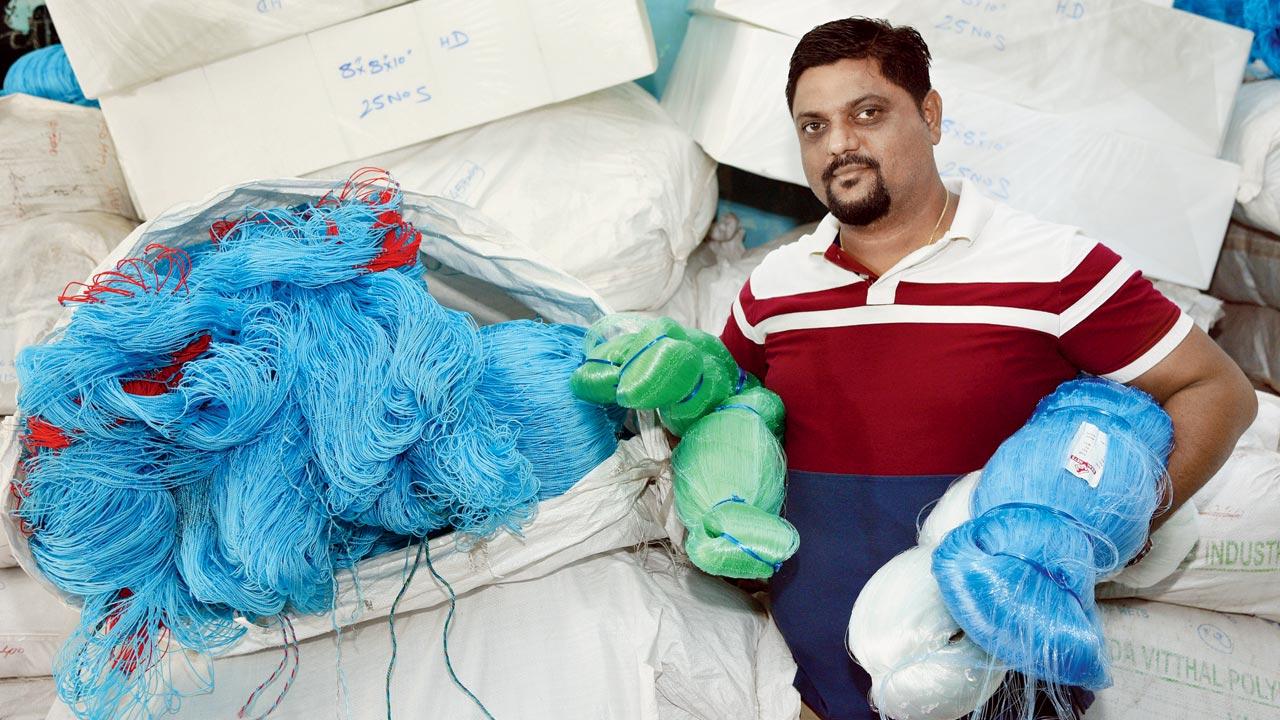 Kiran Tare, who works at the Satpati Fishermen Sarvoday Sahakari Society Ltd, shows the net (in blue, left) used for gillnet fishing
Kiran Tare, who works at the Satpati Fishermen Sarvoday Sahakari Society Ltd, shows the net (in blue, left) used for gillnet fishing
A primary reason, and one that requires introspection by the region’s fishing community itself, is overfishing, which has a direct impact on the life-cycle of the species. As chairman of the society, Chandrakant is aware of this, and has hence demanded the state government’s intervention. “At present, the ban on fishing is just 61 days [from June 1 to July 31]; it should extend to 75 days,” he says, explaining why: Pomfrets lay eggs between November to March near corals. April onwards, baby pomfrets start hatching. The fishing ban is meant to help the pomfret mature. “Pomfrets grow at a very fast rate, but for them to grow to their fullest size, you need to wait at least till late August or September,” says Chandrakant. In the older days, fishermen would not spread their nets during the entire monsoon season, which would last over 120 days. Unfortunately, he says, these days many fishermen sneak out before the ban is lifted. “We know of those who leave by July 24. How are you going to get larger-sized fish?” he asks. “This is not in our control. The government needs to impose the ban more strictly, and for a longer duration.”
Pomfrets are available in abundance anywhere between 14 and 50 nautical miles from the sea. While the fishing ground has increased, many fishermen have also moved from traditional gillnet fishing—a wall of netting that hangs in the water, typically made of monofilament or multifilament nylon—which had a larger mesh size to trap only large fish, to using invasive techniques. Bottom trawling, for instance, which herds and captures ground fish by towing a net along the ocean floor; and bag/dol netting, where the mesh size is smaller and its thickness thinner, to procure smaller-sized fish.
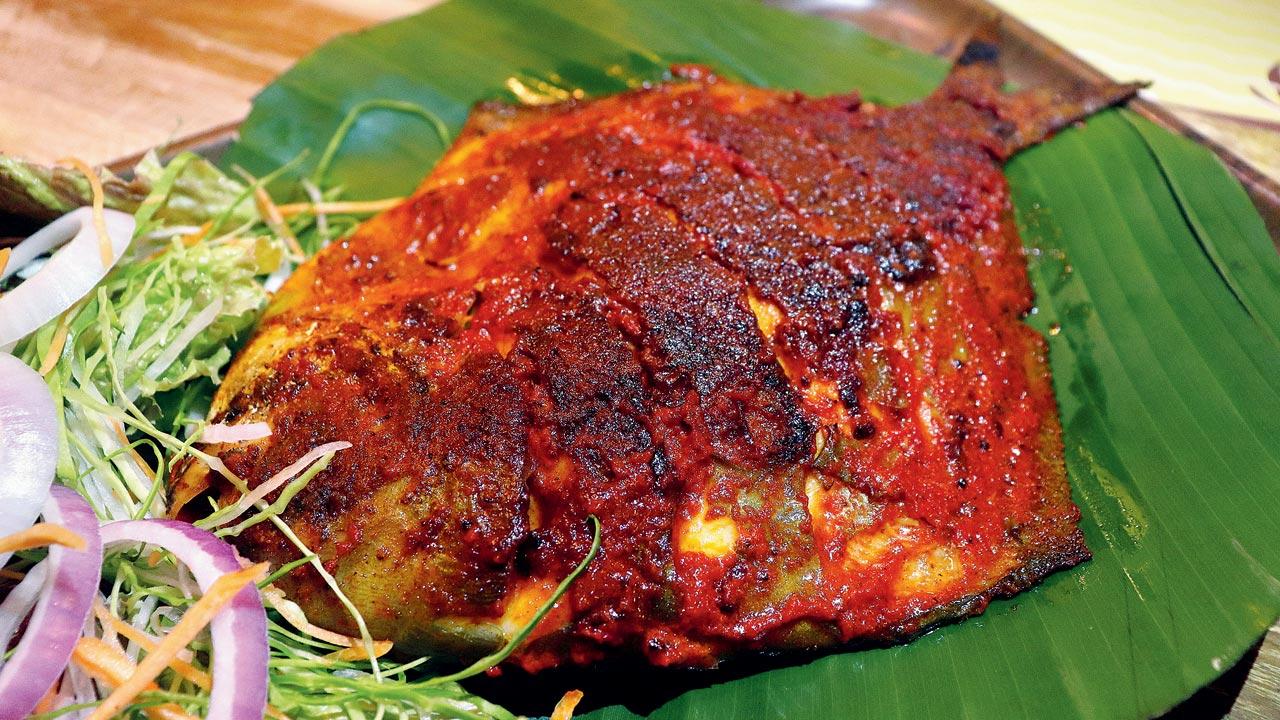 Suraj Shetty, partner at Mahesh Lunch Home, says that the tawa fry pomfret is the most sought-after dish at their restaurant. Pics/Anurag Ahire
Suraj Shetty, partner at Mahesh Lunch Home, says that the tawa fry pomfret is the most sought-after dish at their restaurant. Pics/Anurag Ahire
“The fishermen want maximum catch, but juvenile pomfrets get entangled,” Chandrakant says. While juvenile pomfret are not popular among locals, they still sell. “In Gujarat, they are powdered and used as fishmeal,” says Sanjay.
Prof Bhushan Bhoir, oceanographer and assistant professor at a suburban college, who has done extensive research on the marine biodiversity in and around Vadhavan in the Palghar district, says pollution has also led to drop in the fish population on the Western coastal belt. Pomfrets rely on phytoplankton and zooplankton for food. “In the olden days, when the creeks were healthy, these plankton would develop due to the inflow of nutrients from the creek into the sea. The seaward area served as the perfect ecology for both, breeding and feeding.” Industrial development in the region in the last 30 years has polluted the creeks. This drop in water quality has affected their food sources, and reduced the population and catch of the fish.
 Suraj Shetty
Suraj Shetty
Climate change, global warming in particular, has also played a part. “All fish are sensitive to water temperatures,” says Bhoir, “Even if there’s a one or two degree rise in ocean temperature, they will migrate to escape the warmth.” Heated waters also have lesser capacity to carry oxygen. “For pomfrets to develop, you need a good winter. If the oceans are cooler, larger quantity of oxygen will mix with the water, creating favourable conditions for phytoplankton and zooplankton to grow.” He suspects that at some point, fish available in the western coast, including pomfret, will move towards the Gujarat coast, and from there on, to the coastline near Pakistan. “This is already happening. While chasing their catch, many of our fishermen cross the international maritime border that India shares with Pakistan.”
The Satpati Fishermen Sarvoday Sahakari Society Ltd also provides infrastructure such as ice, ration, nets, boat repair, diesel, cold storage, and bank loans at 8 per cent interest to its fishermen. “Every year, before fishing season, the kolis approach us for loans. They need it to repair and paint their boats, procure new nets, pay for labour chargers [every boat needs to 10 to 15 people], the pilot, food and water they will need while at sea,” says Sanjay. “Some of them take loans of up to R5 to R10 lakh; they are completely reliant on the catch to be able to repay it.” Last year, a boat had an accident mid-sea, and the fishermen were given a compensation of R9,900 by the state government. “That’s how they end up neck-deep in loans.”
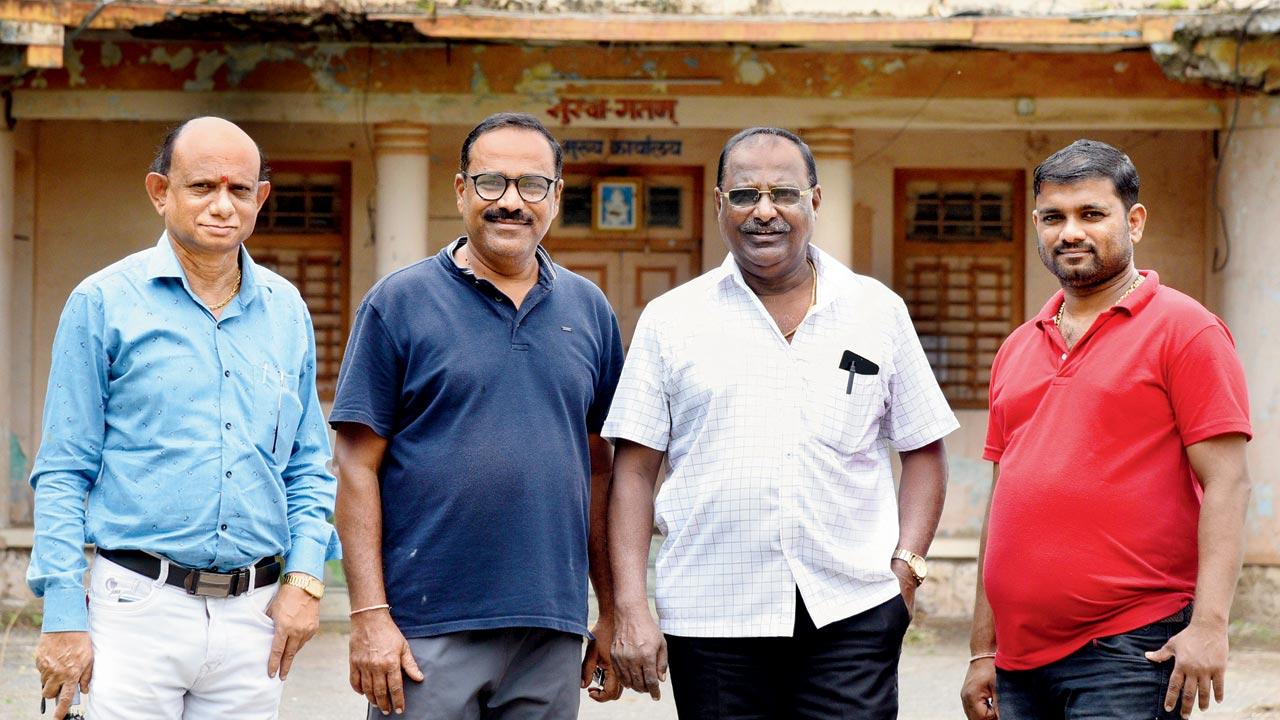 Chandrakant Tare (in white), chairman of Satpati Fishermen Sarvoday Sahakari Society Ltd, along with the ex-chairman Sanjay Tare and other members outside the old building of the society
Chandrakant Tare (in white), chairman of Satpati Fishermen Sarvoday Sahakari Society Ltd, along with the ex-chairman Sanjay Tare and other members outside the old building of the society
A large chunk of the business comes from export, including that of pomfret. “But only super pomfret, grade 1 and grade 2 are in demand. If we don’t have larger-sized pomfret, what are we going to export?” he asks. “Until five years ago, we were able to recover loans right after the fishing season, but in the last few years, especially after COVID-19 which saw several cyclones, it has become nearly impossible.” “The government should try and help fishermen with diesel subsidies and reduce loan interest rates,” says Sanjay.
The ever-spiralling losses have led fishermen in Satpati to abandon fishing. Many have taken up daily-wage paying jobs, or have started working with the Maharashtra Industrial Development Corporation in Palghar.
 Bhushan Bhoir, an oceanographer who has done extensive research on the marine biodiversity in and around Vadhavan in Palghar district, says pollution and global warming on the Western coastal belt has led to drop in catch
Bhushan Bhoir, an oceanographer who has done extensive research on the marine biodiversity in and around Vadhavan in Palghar district, says pollution and global warming on the Western coastal belt has led to drop in catch
There’s also an entire ecosystem of people reliant on pomfret catch, including Koli women, who sell the fish in local markets. Dr Nitya Rao, Professor, Gender and Development with the University of East Anglia, had researched about how drop in bombil (Bombay duck) catch in the Satpati-Dahanu zone caused Koli fisherwomen to work harder or shift to assembly line work. “The impact was direct because these women were also involved in drying of the fish [apart from selling it]. Many were forced to work in nearby factories to sustain households,” she says. With pomfret catch reducing, the overall household income, says Prof Rao, will definitely be impacted. “When the household has to survive, somehow it’s the women who end up taking up various kinds of activities, because while fishermen go out to the sea, the women are left responsible for managing the home and the money. Traditionally, they have done home-based work, like making metal jewellery and bindis. It’s low-paying, but they try and do it in their extra time. So, if they go out to sell fish in the morning, they take up these odd jobs later in the afternoon or evening. Their work day expands.” The further the reduction in catch, the greater the reliance on these odd jobs or diversification into other kinds of work. “It also leads to an increase in indebtedness, as they take small loans from shops or credit groups.” There’s also a long-term impact, says Rao. “Most of them aspire to keep their children out of fishing by investing in education.”
Speaking with mid-day, Sudhir Mungantiwar, State Minister for Forests, Cultural Affairs, Fisheries, says that with regards to the 61-day fishing ban period, they are only following Centre’s orders. “But if the fishermen want us to extend the ban period, the government would be more than happy to comply. The fishing societies need to come together and ask for it. The problem is that there’s a lot of infighting within the community. Even right now, with the two-month ban, we are seeing fishermen break the law.”
 Ganesh Nakhawa, a seventh generation Koli fisherman, says fishermen should take up fishing improvement projects and awareness programmes to self-regulate fishing activity
Ganesh Nakhawa, a seventh generation Koli fisherman, says fishermen should take up fishing improvement projects and awareness programmes to self-regulate fishing activity
Meanwhile, in Worli Koliwada, fishermen say the ongoing Coastal Road construction work has put a dampener on their activity. The cyclones, Nisarga (2020) and Tauktae (2021), which missed Mumbai’s coastline by a hair’s breadth, have also contributed to the catch depleting in the last few years. “Pomfret catch dropped to 20 per cent from last year,” says Nitesh Patil, president of the Worli Koliwada Nakhwa Matsya Vyavsay Sahakari Society. “There’s also a lot of plastic in the ocean. How do you expect fish to survive in such pollution?”
In 2018, Koli singer-songwriter-composer Chintamani Shivdikar’s song Papletwaali, an adaptation of the Marathi folk song Agho Sargewali, released by Zubaan—a music project that connects indie artistes from different parts of the country—took the fishing community by storm. The Marathi music video shows Shivdikar sing and flirt with a Papletwaali, a fisherwoman selling pomfret, saying: “Agho Pampletwaali! Hosheel ka maazhi nauvri? Majhe manane bharlis kauri! (O pomfret-seller! Will you be mine? Oh how my mind is so full of you!).”
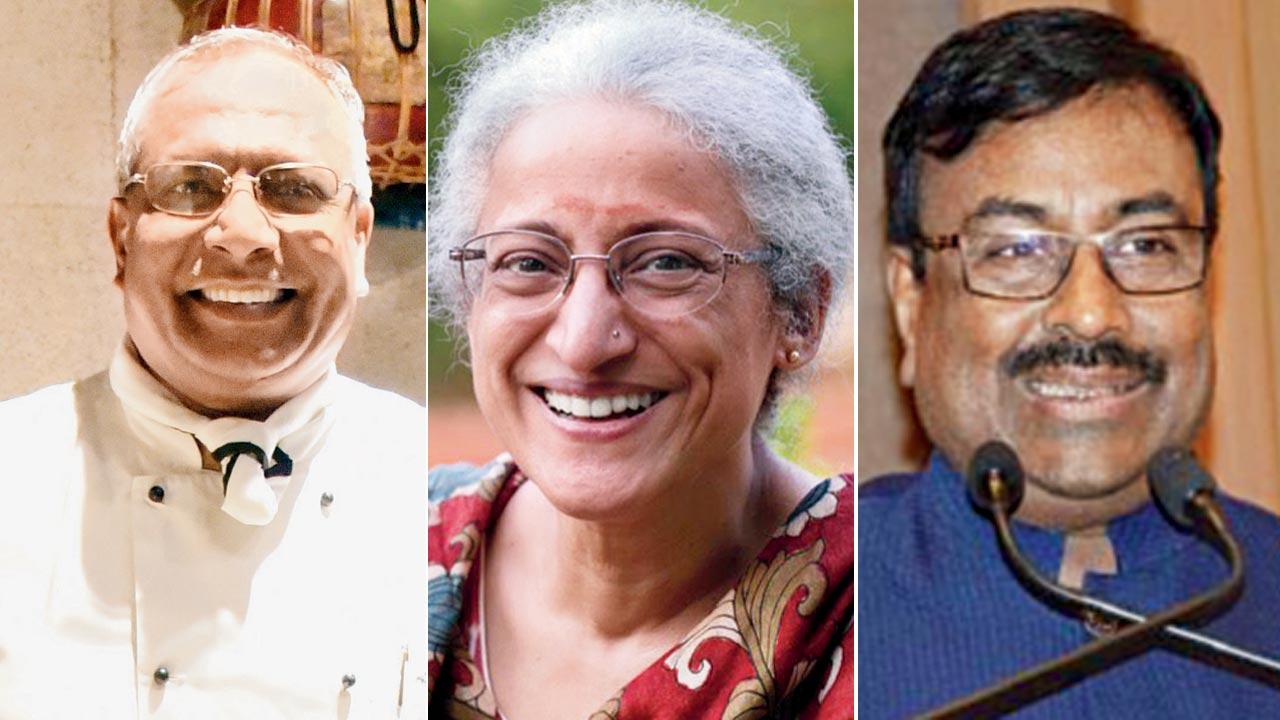 Ananda Solomon, Dr Nitya Rao and Sudhir Mungantiwar
Ananda Solomon, Dr Nitya Rao and Sudhir Mungantiwar
Paplet continues to be an essential part of the cultural consciousness of the Koli fishing community with folksongs, lore and legend about it, says Ganesh Nakhawa, a seventh generation Koli fisherman. He runs the popular Instagram handle @thelastfishermanofbombay, where he spreads awareness about the wide and varied marine life on the western coast, and the issues his community faces. Nakhawa, who is founder and CEO of BluCatch, a raw seafood delivery service, says pomfret, for large-scale export, is mostly procured from Thane-Palghar belt up to Gujarat. “It’s also available in Bay of Bengal.”
He says that it’s not just fishermen and the overfishing that are to be blamed for the current pomfret crisis. “There’s an entire demand and supply chain responsible for this,” he says, “Yes, small [juvenile] pomfret shouldn’t be caught and sold, but it shouldn’t be bought by us either, but it’s still in demand, be it in homes or in the catering industry. Why should all the regulations be for fishermen only?”
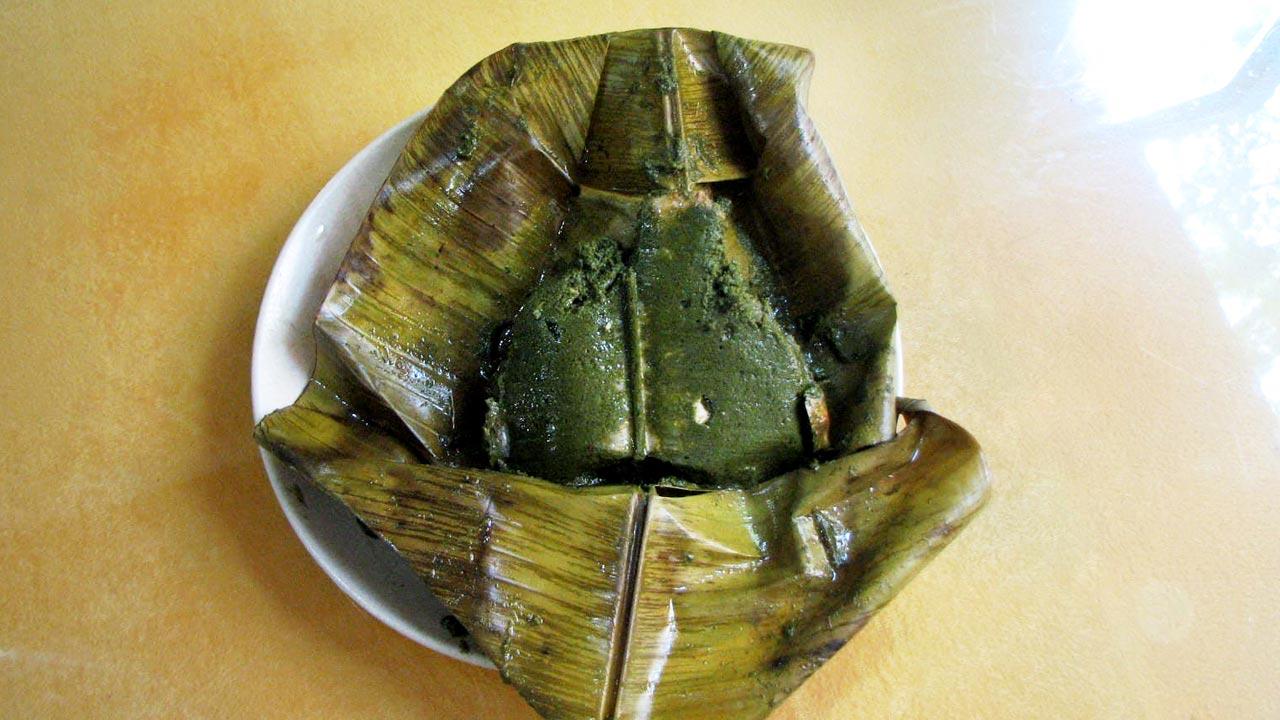 Patra ni machchi, a popular steamed dish in which pomfret is slathered with copious amounts of green chutney and wrapped in banana leaf, is most sought after at Jimmy Boy restaurant in Fort
Patra ni machchi, a popular steamed dish in which pomfret is slathered with copious amounts of green chutney and wrapped in banana leaf, is most sought after at Jimmy Boy restaurant in Fort
He feels that in light of the current apathy by the government, fishermen should take up fishing improvement projects and awareness programmes to self-regulate fishing activity. While he understands the economic value of the fish—“in the 1980s and ’90s, the entire livelihood of the Koli fishing community depended on pomfret”—because of its popularity locally, he feels there’s a need for those in the fishing and hospitality industry to shift the focus from it. “If you go to a seafood restaurant, everyone wants to eat pomfret. I am not a fan of the fish because, for starters, I can’t afford to eat it 365 days of the year, and I can’t even catch it through the year,” says Nakhawa. “I think chefs and food bloggers too, have only been promoting pomfret.”
Ananda Solomon, Executive Chef and CEO Bharat Excellensea, who has worked at iconic restaurants such as Thai Pavilion and The Konkan Café at the Taj President Hotel, describes pomfret as a delicate fish. “It has a single bone, and doesn’t have a strong body smell or fishy taste,” he says, explaining why people prefer it most. “It also has takers abroad, [as it has in India], because more and more Indians/Asians are moving to western countries, and have the buying power.”
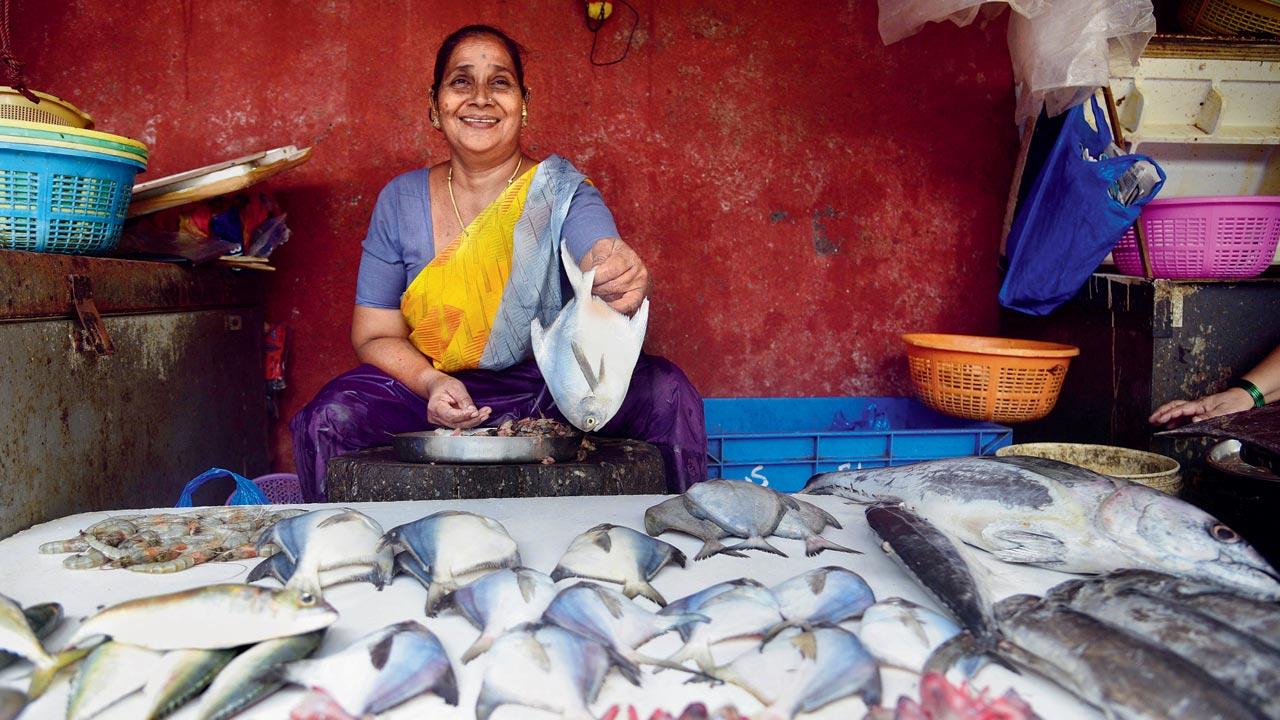 Fishmonger Suvarna Tawde seen selling medium-sized pomfrets at the fish market in Pratiksha Nagar, Sion. Tawde says that while there’s a huge demand for super-sized paplet, they are hard to procure
Fishmonger Suvarna Tawde seen selling medium-sized pomfrets at the fish market in Pratiksha Nagar, Sion. Tawde says that while there’s a huge demand for super-sized paplet, they are hard to procure
At Mahesh Lunch Home, a premium sea food speciality restaurant, with five outlets in Juhu, Navi Mumbai and Fort among others, pomfret is the most sought-after fish. Their tandoori and tawa fry pomfret, and paplet curry are in such a high demand that their suppliers have had to spread themselves thin, says Suraj Shetty, partner at the restaurant. “When it’s not in season in Maharashtra, we procure it from Gujarat and even West Bengal,” he says, adding, “There’s never been a day where we don’t serve pomfret.”
If the Maharashtrians like their paplet delicately fried, the Parsis relish it steamed. At Jimmy Boy in Fort, every alternate order is the patra ni machchi, a popular steamed dish in which pomfret is slathered with copious amounts of green chutney and wrapped in banana leaf, or saas ni machchi, which is prepared in a white sauce. “We are very particular about the size of pomfret; we want nothing less than 300 gm raw weight,” says Sherzad Irani of Jimmy Boy. For the Parsis, there’s no close second to the pomfret. “And they are a big fan of the puchri [the tail piece]. If you give them a surmai or any other fish, they’ll sulk,” he says, adding that it’s perhaps because the Zoroastrian community, first landed in Gujarat, where pomfret and boi were widely available.
Shetty of Mahesh Lunch Home admits that in recent years, there has been a decline in pomfret catch in the Arabian Sea, due to which the price of pomfret has become as volatile as the stock market. A jumbo pomfret at the restaurant is currently priced at R1,300. Chef Solomon, however, says there’s a need to investigate who is putting such a high price tag on the fish, because that’s also playing a role in its availability or unavailability in the market.
At Ferry Wharf Restaurant in Bandra Reclamation, which serves authentic Mangalorean seafood, Chef Sanika Shetty says there has been a deliberate attempt to make diners aware of other options on the menu. “Of late, sourcing has been difficult, even though we procure it from all over India, including Vishakhapatnam and Gujarat,” says Shetty, adding that they are biased toward the large-sized sample because “we are conscious of how juvenile fishing has affected the breeding of the fish”. As a practice, Shetty says, before ordering, the wait staff present diners with a platter of the day’s catch—it would include lobster, surmai, mackerel (bangda), tiger prawns and pomfret. “If they are not aware of the fish, we tell them about it. This helps them make a better choice.”
Rs 25cr
Average income fishing village of Satpati in Palghar earns from export and local sale of pomfret or saranga
1,46,797kg
Super saranga haul in 1990-91
33,184kg
Super saranga haul in 1999-2000
4,508kg
Super saranga haul in 2022-23
 Subscribe today by clicking the link and stay updated with the latest news!" Click here!
Subscribe today by clicking the link and stay updated with the latest news!" Click here!







